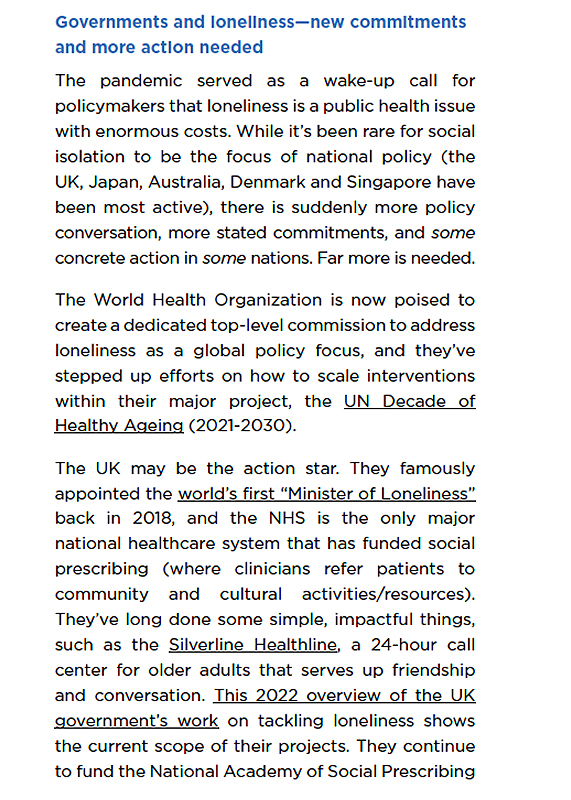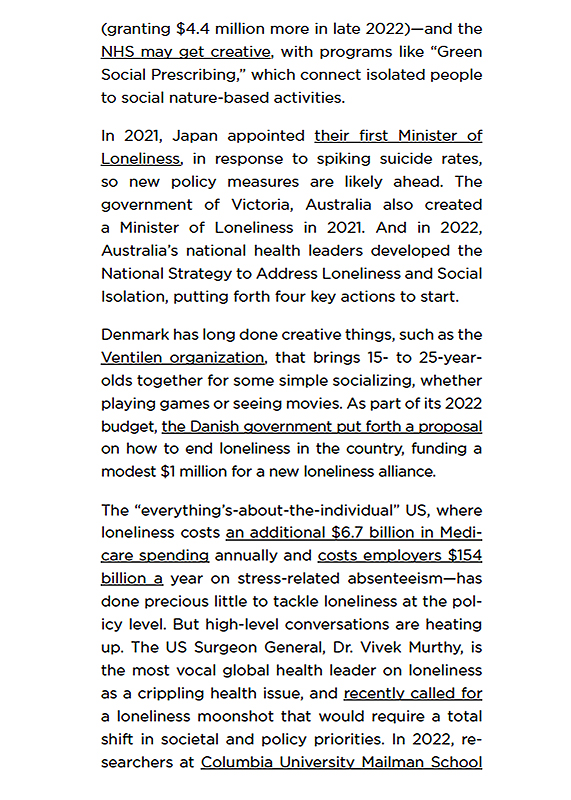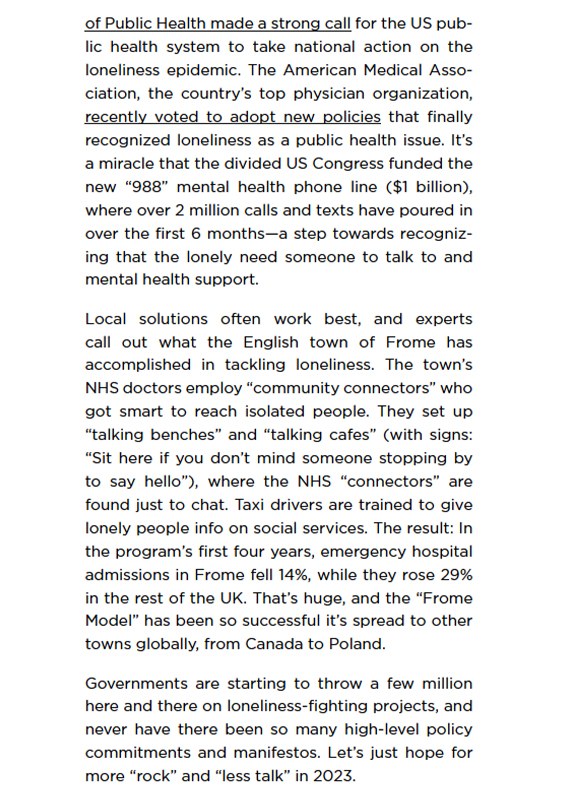
Governments Ramp Up the War on Loneliness
From the US Surgeon General’s unprecedented public health advisory and new national framework on the American loneliness crisis last week, to South Korea announcing that it would give isolated young people $500 a month to get out of the house, there are recent signs that more governments are taking loneliness seriously
Our 2023 trend, “Wellness Comes for the Loneliness Epidemic,” explores how the biggest movement in wellness is engineering the “social” and community. But it also goes in-depth on how tackling loneliness is a macro trend extending far beyond the wellness market, because no matter how many social wellness clubs and concepts launch, they could never tackle the global crisis at scale, given that only a tiny percentage of the population has the resources or motivation to use them. Policy is key, and the trend discusses how with the wake-up call of the pandemic, more governments are tackling loneliness as a runaway public health issue with staggering costs. There are suddenly more policy conversations, more bold commitments, and some concrete action—from Japan and Victoria, Australia appointing ministers of loneliness in 2021 to the UK increasing its spend on its first ever cross-government strategy to tackle loneliness, which includes new “social prescription” programs.
There’s been some striking action on the loneliness policy front these last months, and an update felt needed.
Just last week, the US Surgeon General, Vivek Murthy, MD, (a keynote speaker at the 2020 GWS) issued an advisory on the “epidemic of loneliness and isolation” affecting the country and laid out a framework for a “National Strategy to Advance Social Connection.” This is unprecedented: advisories from America’s top doctor are reserved for public health challenges that require immediate attention. Murthy detailed the crisis (more than half of Americans are now lonely); the health costs (loneliness causes a risk of premature death comparable to smoking, and maybe even more than obesity); and the economic price-tag ($6.7 billion annually in excess Medicare spending alone). The new policy framework to rebuild social connection in lonely, polarized and violent America revolves around six pillars. Murthy called for new “social infrastructure” policies, from school-based programs that teach healthy relationships, to workplace design that drives connection, to far more community programs that bring people together, whether libraries or green spaces. He called for a radical renegotiating of our relationship to technology (from mandating data transparency from tech firms to new age-related protections) and new spending to educate the healthcare system on loneliness and help them address it as part of care. Now we watch to see how this historic framework plays out with new spending and legislation.
In April, South Korea put real money down on a real first: paying people to socialize. With the pandemic creating a growing population of young people who have become severe social recluses, the government is giving socially isolated people aged 9-24 a $500 monthly stipend to get out of the house and back in society: to go to school, to university, to work, to socialize. And the measure also offers them education, job and health support.
There’s much to discuss. In March, the UK launched a new $30 million fund (the Know Your Neighborhood Fund) to tackle loneliness, that will develop a volunteering program, and new arts and crafts and social events, sports and coffee sessions, for disadvantaged areas. Sweden’s new health policy agenda is squarely aimed at combatting loneliness. In Japan, a new government survey revealed that 1.5 million people have withdrawn from society (called hikikomori, or shut-ins, defined as people who have been isolated for at least six months), and it prompted the government to unveil a more intensive plan at the end of 2022. It includes expanding home visit programs, hiring more school counselors and social workers, and investing in a 24/7 phone help service for the lonely. Hyper-local actions typically work best, and what the Dutch grocery store chain Jumbo has done as part of the government’s One Against Loneliness campaign is inspired: creating slow “chat checkout” lanes where cashiers take time to talk with people (it may be their only human contact that week). They’ve also created chat corners for coffee and conversation and if 120 stores have them now, by next year 200 will.
High-level loneliness policy commitments are heating up. Yes, it can often be more “talk” than “rock,” but tangible action is underway. Far, far more is needed, because loneliness is no temporary pandemic trend: All the forces driving it—our increasingly single, “kinless,” aging, urban, remote work and digitally-engulfed world—are only expected to accelerate.



Buy the full “Future of Wellness: 2023 Trends” report, a 160-page analysis of what’s ahead for the business of wellness.
The TRENDIUM is a compendium of the latest trends impacting the
multi-trillion dollar global wellness economy.
Sign-up for monthly TRENDIUM emails.
